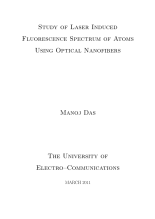Study of laser induced fluorescence spectrum of atoms using optical nanofibers ナノ光ファイバーによる原子のレーザー誘起蛍光スペクトルの研究
この論文にアクセスする
この論文をさがす
著者
書誌事項
- タイトル
-
Study of laser induced fluorescence spectrum of atoms using optical nanofibers
- タイトル別名
-
ナノ光ファイバーによる原子のレーザー誘起蛍光スペクトルの研究
- 著者名
-
Das Manoj
- 著者別名
-
ダス マノジ
- 学位授与大学
-
電気通信大学
- 取得学位
-
博士 (理学)
- 学位授与番号
-
甲第627号
- 学位授与年月日
-
2011-03-24
注記・抄録
博士論文
2010
Fluorescence of atoms has been the subject of interest in quantum optical measurementsfor many years. The atomic fluorescence is routinely used as a tool to detectatoms, to generate photons and to generate non-classical states of light. One of thewidely used methods to investigate the atomic fluorescence is laser-induced fluorescencespectroscopy. This thesis presents the development of optical nanofibers as atool for the measurement of fluorescence spectrum of atoms.Optical nanofibers are ultrathin optical fibers, with diameters less than the propagationwavelength of the fiber, with a silica core and a vacuum clad. Such opticalnanofibers can support only the single propagating guided-mode. The guided-modesof the nanofiber is confined in the transverse direction of the nanofiber and a partof the propagating field lies outside the fiber, in the evanescent region of the fiber.The mode density of the electromagnetic field is modified by the nanofiber. Due tothe modification of mode density, the spontaneous emission of atoms is modified bythe optical nanofibers and the confinement of the guided-modes results in a strongchanneling of spontaneous emission of atoms into the guided-modes of the nanofiber.Such a property of nanofibers can be used to study fluorescence of atoms around thenanofiber.Optical nanofibers are prepared by the adiabatic tapering of single-mode opticalfibers. Our experiments are performed by overlapping cold Cesium atoms, from amagneto-optical trap (MOT), with the optical nanofiber and observing the fluorescencethrough the guided-modes of the nanofiber. The nanofiber suppresses with highprobability any coupling of scattering light from the excitation laser into the guidedmodesand high coupling efficiency of fluorescence into the guided-modes enables us tomeasure the fluorescence spectrum of atoms present around the nanofiber with a goodsignal-to-noise ratio. In this thesis, we demonstrate the measurement of laser inducedfluorescence (LIF) emission spectra of strongly driven atoms using optical nanofibers.For the fluorescence emission spectrum measurements, we develop and demonstrate anew sensitive and high resolution method consisting of optical heterodyne techniqueand photon correlation spectroscopy. The key point of the method is to extract theinformation of first-order field correlation function from the measured second-orderintensity correlation function. The Fourier transform of the field correlation functionthen gives the fluorescence emission spectrum.The atoms emitting fluorescence in the guided-modes of the nanofiber lie very closeto the nanofiber surface and are subjected to atom-surface interactions. It has beenreported in earlier experiments on nanofiber, that such surface interactions can bemodified by irradiating the MOT-atoms overlapped with the nanofiber with UV lasers.After such irradiations, MOT-atoms are kept from falling into the surface-potentialand behave almost like free-space atoms around the nanofiber. We first perform ourfluorescence spectra measurements under this free-atom conditions. The observedexcitation spectrum lineshape shows a free-atom like Lorentzian behavior, with avery small tail in the red-detuned side (red-tail). The red-tail has been attributedto photoassociation process, due to atoms making transition from free ground statesto bound excited states of the surface potential. Under this conditions, the emissionspectra measured for on-resonant and off-resonant excitations show the well-knownthree-peak Mollow-triplet spectrum of free-space two-level atoms. The observationconfirms that the near surface atoms behave like free-space atoms. Also, the quantitativeagreement between the observed spectra with the theoretical calculationsdemonstrates the validity of the optical nanofiber method for measuring fluorescenceemission spectrum of atoms.As mentioned above, since we are observing near-surface atoms, fluorescence measurementsbased on optical nanofibers may become a unique tool to probe atomsurfaceinteractions. In earlier experiments using nanofiber, signatures of atomsurfaceinteraction have been observed in the excitation spectrum of atoms, in theform of a broad red-tail. The lineshape of the excitation spectrum is understood as aresult of a process where atoms approaching the nanofiber surface fall into the shallowsurface potential, forming long-range atom-surface bound states. In this thesis,we have systematically investigated the evolution of the lineshape of the excitationspectrum from a Lorentzian shape to a broad red-tail condition. The evolution of thespectrum lineshape has been attributed to the changing nanofiber surface condition.The spectrum shape is found to depend on the flux of background Cs-atoms. Wespeculate that this might be due to the adsorption of hot background atoms ontothe nanofiber surface, which changes the surface condition of the nanofiber locallyand helps in loading of cold MOT-atoms into the shallow surface potential. We havefound that the effect of UV laser irradiation is to photoionize the MOT-atoms, andthe generated photoelectrons might help in the desorption of adsorbed atoms on thesurface. We discuss the roles of adsorption and desorption of atoms on the surfaceconditions. We have shown that such changing surface condition can be controlledby adjusting the hot background atom flux and the UV laser intensity. Under suchcontrolled surface condition, we have measured the emission spectrum. The observedemission spectrum under the broad red-tail condition can be explained only by includingthe surface interactions. We also discuss qualitatively the phonon-mode densityfor nanofiber at room temperature and the phonon-mediated decay of atoms in thesurface potential.This work may open up the way for using optical nanofibers as a tool to investigatethe laser-induced fluorescence spectrum of strongly driven atoms, and to study atomsurfaceinteractions. In the future, we hope to create optical dipole traps around thenanofibers by introducing trap laser lights through the guided-modes and performfluorescence measurements of these trapped atoms.
